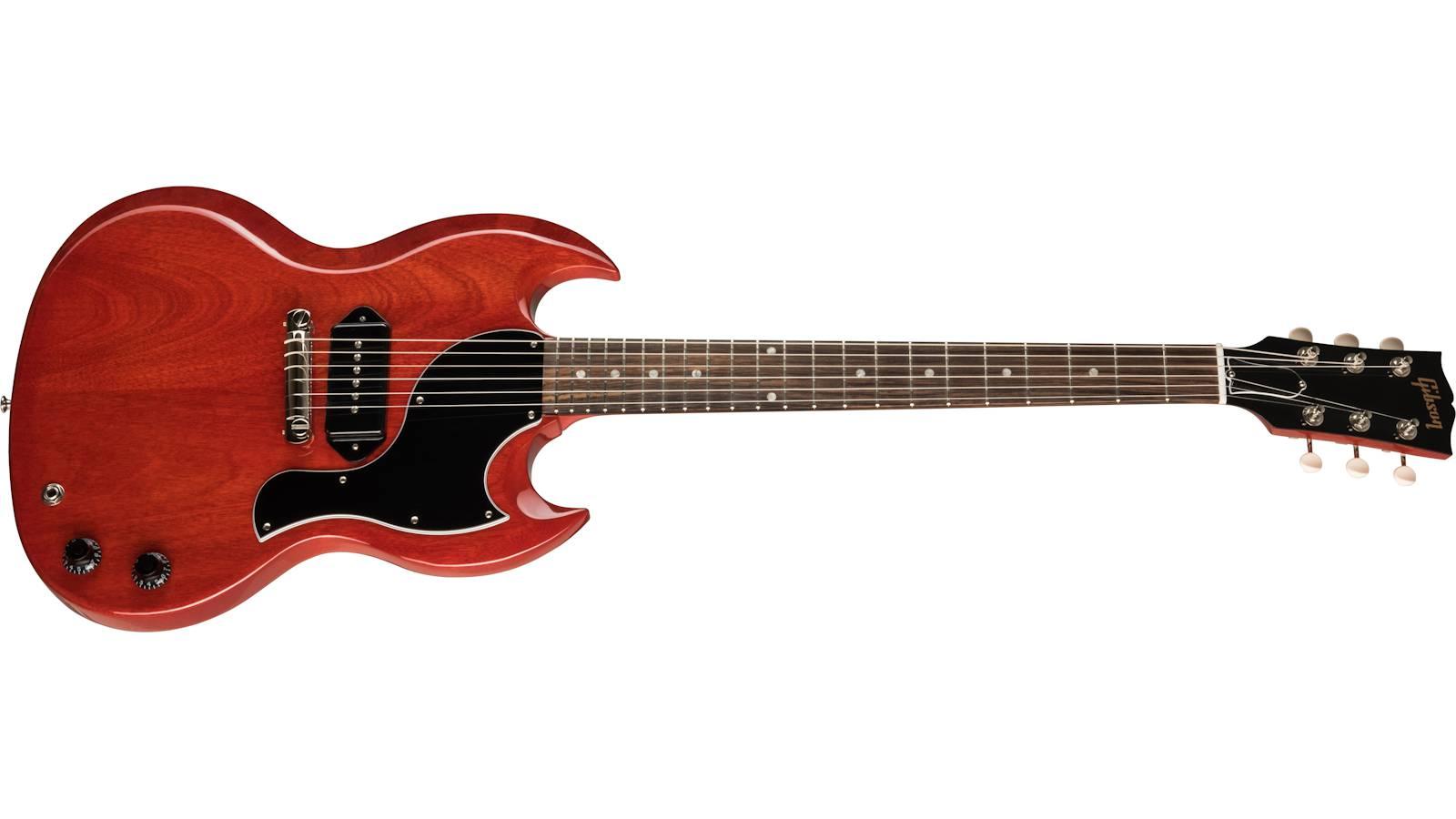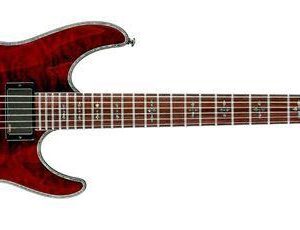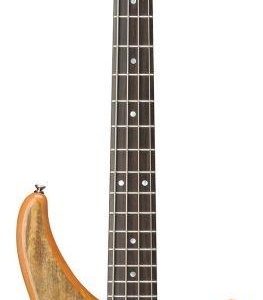Gibson SG Junior
$938.99
Get ready to rock out with the legendary Gibson SG Junior electric guitar – known for its classic design and incredible sound!
Compare
Description
The Gibson SG Junior is a classic electric guitar that has been an essential part of the music scene for over 50 years. It is considered one of the most iconic models from the brand, and for good reason. This stripped-down guitar is perfect for those looking to focus on the essence of rock and roll music. Here’s everything you need to know about the Gibson SG Junior electric guitar:
History
The Gibson SG Junior was first introduced in the early 1960s as a budget model. It was designed to be simple and affordable for young guitarists who wanted a stripped-down guitar that could deliver a punchy sound. The SG Junior quickly became popular among music fans and musicians, creating a cult following that still exists to this day.
Design
The SG Junior is designed for simplicity. It features a single P-90 pickup, a wraparound tailpiece, and a single-cutaway, solid Mahogany body. The simplicity of the design makes it a guitar that is easy to play, and the lightness of the instrument means you can move around the stage with ease.
Sound
The P-90 pickup produces a raw and aggressive sound that has become synonymous with rock music. The guitar has a clear, warm tone that allows you to cut through the mix, perfect for players who want to make a statement with their sound. The guitar’s simplicity means there are no tone controls or switches, so you can focus on getting the right sound simply by adjusting your playing style.
Why Choose the Gibson SG Junior?
If you’re a fan of rock and roll music, the Gibson SG Junior is a guitar that should be in your collection. It’s an affordable model that delivers a raw and powerful sound, making it perfect for those looking to cut through a mix of instruments. The stripped-down design means it’s easy to play and move around on stage, making it perfect for live performances.
Conclusion
The Gibson SG Junior is a classic electric guitar that has been an essential part of rock and roll music for over 50 years. Its simplicity, affordability, and powerful sound have made it a favorite among musicians and fans alike. If you’re a guitarist looking to get a raw and powerful sound, the Gibson SG Junior should be at the top of your list. It’s an excellent choice for beginners and experienced players alike.
Gibson SG Junior properties
| Product name |
Gibson SG Junior |
| Brand |
Gibson |
| Type |
Electric Guitar |
| Number of Strings |
6 pcs |
| Handedness |
Right-Handed |
| Number of Frets |
22 |
| Cutaway |
Double Cutaway |
| Size |
4/4 |
| Wood Type (front) |
Mahogany |
| Wood Type (neck) |
Mahogany |
| Wood Type (fretboard) |
Rosewood |
| Colour |
Red |
Frequently Asked Questions:
What are the steps for proper set up and maintenance of my Gibson SG Junior guitar?
As a guitar technician, I can provide you with detailed guidance on how to properly set up and maintain your Gibson SG Junior guitar. Here's a step-by-step process:
1. Cleaning the Guitar:
Before starting any adjustments or maintenance, it is important to clean the guitar thoroughly. Use a soft cloth to gently wipe down the body, neck, and fretboard of your SG Junior. You can use a mild soap solution if needed, but make sure it's completely dry before moving on to the next step.
2. Checking the Strings:
Examine the strings for signs of wear or damage. If they are frayed or rusted, replace them with new ones. The correct gauge and type of strings can have a significant impact on your guitar's playability and tone. Gibson recommends using their own brand of strings, but there are many other high-quality options available as well.
3. Adjusting the Neck:
The neck should be straight and level. To check this, place a straight edge along the fretboard at various points between the first and twelfth frets. If it doesn't sit flat against the strings, you may need to adjust the truss rod. Turning the truss rod clockwise will make the neck straighter, while turning it counterclockwise will make it more bowed. Make small adjustments until you achieve the desired neck angle.
4. Setting Up the Bridge:
The bridge is responsible for holding the strings in place and transferring their vibration to the body of the guitar. If your SG Junior has a Tune-o-Matic bridge, ensure that all saddles are seated properly and evenly spaced. Adjust the intonation by moving each saddle along its slot until the string's length from the bridge to the twelfth fret matches its actual pitch when plucked open.
5. Setting Up the Nut:
The nut is a small piece of material (usually bone or plastic) that guides the strings as they leave the headstock. It should be cut accurately so that the strings sit flush with it without any gaps or excessive tension. If necessary, use a nut file to shave off excess material until the strings fit correctly.
6. Tuning and Playability:
Once you've completed all of these steps, tune your guitar using an electronic tuner or by ear. Strum each string individually to ensure that they are all in tune with one another. Finally, play chords and scales across the fretboard to check for any fret buzzing or other issues that may require further adjustment.
7. Regular Maintenance:
To keep your Gibson SG Junior guitar in optimal condition, perform regular maintenance checks and cleanings. This includes changing strings as needed, cleaning the fretboard with a specialized cleaner, and polishing the finish to protect against wear and tear.
By following these steps and taking proper care of your guitar, you'll ensure that it remains in excellent playing condition for years to come.
What is the difference between the Gibson SG Junior and the Epiphone Casino in terms of playability and tone?
The Gibson SG Junior and the Epiphone Casino are both popular electric guitars, but they have some differences in terms of playability and tone. The Gibson SG Junior has a slimmer neck profile (1st and 2nd fret width) and a lighter weight overall, making it more comfortable for players who prefer a slim profile or a lighter guitar. It also tends to have a slightly brighter and more focused tonality, with a bit more sustain compared to the Epiphone Casino. The Epiphone Casino has a wider neck profile (3rd and 4th fret width) and is somewhat heavier than the Gibson SG Junior, but still relatively easy to play for most players. It tends to have a warmer and more balanced tonality, making it a popular choice for blues and rock players who prefer a slightly darker tone. Ultimately, the choice between these two guitars comes down to personal preference in terms of playability and tone.
"What is the difference in electronics between a Gibson SG Standard and a Gibson SG Junior, and how does it affect the guitar's tone?"
The main differences in electronics between a Gibson SG Standard and a Gibson SG Junior lie in their pickup configurations and output jack placements. A Gibson SG Standard comes equipped with two humbucker pickups - one at the bridge and another at the neck position. These pickups have two coils of wire around magnets, which cancel out any unwanted background noise or hum (hence the term "humbucker"). The output from these pickups is sent to separate volume and tone controls for each pickup as well as a master tone control that affects both pickups. On the other hand, a Gibson SG Junior only has one humbucker pickup located at the bridge position. This pickup shares its signal with a single volume control and a master tone control. As a result, there is no separate neck pickup or controls for it on this guitar. The difference in pickup configurations directly affects the guitars' tonal characteristics. The Gibson SG Standard has a fuller, richer sound due to the added presence of the neck pickup, which provides more mid-range frequencies. This makes it better suited for playing rhythm guitar and clean melodic lines. The Gibson SG Junior, on the other hand, has a brighter, more focused sound that is better for lead playing and playing in high gain or distorted settings due to its higher output from a single pickup. Another difference between the two guitars lies in their output jack placements. The Gibson SG Standard's output jack is located on the lower bout of the body, while the Gibson SG Junior's output jack is positioned closer to the bridge pickup. This placement can affect how the guitar feels and sounds when it is played, as the positioning of the weighted components can change the balance and resonance of the instrument. In summary, while both guitars share similarities in their humbucker pickups, the Gibson SG Standard's added neck pickup and separate controls for each pickup give it a fuller, richer sound, whereas the Gibson SG Junior's simpler configuration results in a brighter, more focused tone. The placement of the output jack also affects the guitars' overall tonal characteristics.
How can I optimize the tone and performance of a Gibson SG Junior electric guitar through proper setup, adjustment, and maintenance techniques?
To optimize the tone and performance of your Gibson SG Junior electric guitar, here are some tips for proper setup, adjustment, and maintenance techniques:
1. Setup:
- Adjust the intonation by setting the saddles to the correct position using a digital tuner. The strings should be in tune at both the bridge and the nut. Check the neck relief using a truss rod gauge or a piece of paper. A small gap should exist between the fretboard and the neck, but not too much that it affects the intonation. Adjust the action by setting the height of the strings at the bridge and the nut. The strings should be low enough to play comfortably but not so low as to cause string buzz. Set the string gauge based on your playing style. Lighter gauges are better for clean playing, while heavier gauges are better for distortion or heavy rock styles. Adjustment:
- Check the pickup height by adjusting them according to your preferred tone. Lower pickups will provide a warmer and mellower tone, while higher pickups will provide a brighter and more aggressive tone. Adjust the pots (potentiometers) for volume and tone controls. The pots should be cleaned periodically to prevent any interference with the signal flow. Check the capacitor values in the tone circuit according to your playing style. Higher capacitance values will provide a warmer tone, while lower values will provide a brighter tone. Maintenance:
- Clean the guitar regularly using a soft cloth and a small amount of alcohol or water-based cleaner. Avoid using harsh chemicals or abrasive materials that could damage the finish. Lubricate the moving parts such as the tuners, bridge saddles, and knobs with a small amount of machine oil or graphite powder to prevent rust and friction. Check the wiring connections periodically for any loose or damaged connections. Repair or replace any damaged components immediately to prevent electrical interference. By following these tips, you can optimize the tone and performance of your Gibson SG Junior electric guitar, ensuring that it provides a consistent and enjoyable playing experience for years to come.





Reviews
There are no reviews yet.